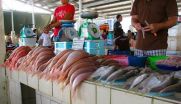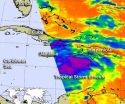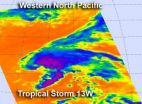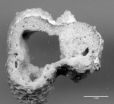(Press-News.org) In a large epidemiologic study, researchers at UCLA's Jonsson Cancer Center found that the children of U.S.-born Latina women are at higher risk of having retinoblastoma, a malignant tumor of the retina which typically occurs in children under six.
The study, which focused on babies born in California, also found that offspring of older fathers were at greater risk for retinoblastoma, as were children born to women with sexually transmitted diseases and those born in multiple births, which may indicate an increased risk from in vitro fertilization. Those findings confirmed the results of several smaller studies.
The research team used data from the California Cancer Registry and examined all retinoblastoma cases reported from 1988 to 2007, said Julia Heck, the study's first author and an assistant researcher in the UCLA Fielding School of Public Health. Using California data allowed the researchers to cull information from a large and diverse population that included many Latinas.
The study appears in the early online edition of the journal Cancer Causes & Control.
"One of the most interesting things we found in this study that hasn't been reported is the differences among Latina mothers and the risk being lower among mothers born in Mexico," Heck said. "We believe this is because women born in Mexico who come to the United States and have children have very healthy behaviors in the perinatal period, immediately before and after giving birth."
Study senior author Dr. Beate Ritz, a Jonsson Cancer Center researcher and professor and chair of epidemiology and professor of environmental health sciences in the Fielding School, said Latinas born in the U.S. are less likely to exhibit the healthy pregnancy behaviors found in foreign-born Latinas. For example, they have poorer diets and are more likely to smoke and drink during pregnancy, which could contribute to the risks of retinoblastoma.
"Compared to U.S.-born Latinas, immigrant women born in rural Mexico often have even less education and lower socioeconomic status, but they retain healthier diets and perinatal habits, which may be correlated to lower risk of disease in their children," Ritz said.
The team chose to study retinoblastoma because its causes remain poorly understood. They sought to examine associations between perinatal factors and cancer risk in California children. They identified 609 retinoblastoma cases, 420 that occurred in one eye (unilateral) and 187 that occurred in both eyes (bilateral). They randomly selected more than 200,000 control children without cancer from the California birth rolls. The source of most of the risk factor data in this study was information from birth certificates, Ritz said.
Retinoblastoma is the result of the loss or mutation of both alleles of the RB1 tumor suppressor gene. About 40 percent of cases are considered hereditary, and most of these present as bilateral disease.
"In conclusion, we observed risk of retinoblastoma to be related to several risk factors," the study states. "Bilateral disease risk was higher among children of older fathers, and among children of multiple birth pregnancies. We observed a higher risk of unilateral disease among children of U.S.-born Latina women. Further research should be done to confirm this finding and to examine the unique risks experienced in this population."
###
The study was funded by the National Institutes of Health's National Institute of Environmental Health Sciences (R21 ES018960 and R21 ES019986.
UCLA's Jonsson Comprehensive Cancer Center has more than 240 researchers and clinicians engaged in disease research, prevention, detection, control, treatment and education. One of the nation's largest comprehensive cancer centers, the Jonsson center is dedicated to promoting research and translating basic science into leading-edge clinical studies. In July 2012, the Jonsson Cancer Center was once again named among the nation's top 10 cancer centers by U.S. News & World Report, a ranking it has held for 12 of the last 13 years. For more information on the Jonsson Cancer Center, visit our website at http://www.cancer.ucla.edu.
END
(Santa Barbara, Calif.) –– Most people think of seafood as either wild or farmed, but in fact both categories may apply to the fish you pick up from your grocery store. In recent years, for example, as much as 40 percent of the Alaskan salmon catch originated in fish hatcheries, although it may be labeled "all wild, never farmed."
An article produced by a working group of UC Santa Barbara's National Center for Ecological Analysis and Synthesis (NCEAS) recommends that when a combination of seafood production techniques are used, this be acknowledged in the marketplace. ...
CORVALLIS, Ore. – Young children who are able to pay attention and persist on a task have a 50 percent greater chance of completing college, according to a new study at Oregon State University.
Tracking a group of 430 preschool-age children, the study gives compelling evidence that social and behavioral skills, such as paying attention, following directions and completing a task may be even more crucial than academic abilities.
And the good news for parents and educators, the researchers said, is that attention and persistence skills are malleable and can be taught.
The ...
Despite a twenty-five year old law that bans "patient dumping" the practice continues to put uninsured Americans at risk, according to a national team of researchers led by a professor at the George Washington School of Public Health and Health Services. Patient dumping is the practice of turning away or transferring uninsured patients with emergency medical conditions.
The study, which appears in the August issue of Health Affairs, suggests that hospitals still practice "patient dumping" which is in violation of the law. The researchers investigate and present five ...
CHAMPAIGN, Ill. — A study from University of Illinois economics professors demonstrates a new method to analyze the relationships among voters' issue preferences, the candidates' policy positions and voter behavior.
Estimating the distribution of voter preferences and the extent of policy divergence between the candidates' platforms, economics professors Stefan Krasa and Mattias Polborn are able to separate observed changes in voter behavior into those driven by voter radicalization versus those caused by increased policy differences between the two parties.
"We have ...
Health coverage for the poorest Americans could be in jeopardy in many states as a result of the U.S. Supreme Court's ruling last month on the Affordable Care Act, according to a new legal analysis. The report examines federal and state Medicaid options following the United States Supreme Court's ruling in NFIB v Sebelius and appears in the August issue of the journal Health Affairs.
"Some states will use the court's decision as an excuse to delay or refuse to participate in the expansion of Medicaid as outlined in the Affordable Care Act," says lead author of the report, ...
URBANA – The trade in ivory was largely outlawed in 1989, but poaching continues and remains a serious threat to the African elephant. Seizures of large amounts of ivory, sometimes over a ton, continue to occur. Research by Alfred Roca, an assistant professor at the university, could be the basis for the development of new law enforcement tools.
Roca has found a way to determine where the ivory comes from. With funding from the Division of International Conservation of the U.S. Fish and Wildlife Service, he and his collaborators have sampled elephants at 22 locations ...
ZURICH — Though sophisticated three-dimensional imagery is abundant in computer-generated games and movies, a group of researchers from Disney Research, Zürich, University of California, San Diego, Limbic Software, and RWTH Aachen University say they have gained insights to improve the rendering of those images by envisioning a flat, two-dimensional world.
The fundamental physics of light is easier to understand in that 2D world than in a 3D environment, they said, and enabled them to develop simplified equations for governing the behavior of light. This in turn allowed ...
VIDEO:
An animation of satellite observations shows the progression of Tropical Storm Ernesto from Aug. 4-6, 2012. The animation begins when Ernesto was south of Jamaica and ends when the storm...
Click here for more information.
Tropical Storm Ernesto continues to track through the Caribbean and satellite data and NOAA hurricane hunter aircraft revealed a strengthening storm mid-day on Monday, August 6. NASA infrared data revealed strong thunderstorms on August 5 that ...
When NASA's Aqua satellite captured an infrared view of the northwestern Pacific's latest tropical storm, Tropical Storm 13W, the data revealed the bulk of the heavy rainfall on the northern side of the center.
NASA's Aqua satellite passed over Tropical Storm 13W on August 6 at 0205 UTC (Aug. 5 10:05 a.m. EDT). The Atmospheric Infrared Sounder (AIRS) instrument captured an infrared image of the cloud temperatures that showed the strongest storms (purple) and heaviest rainfall north and east of the center of circulation.
Infrared imagery shows temperature and the higher ...
Microbes, sponges, and worms—the side effects of pollution and heavy fishing—are adding insult to injury in Kenya's imperiled reef systems, according to a recent study by the Wildlife Conservation Society and the University of Azores.
The authors of the study have found that pollution and overfishing on reef systems have an ecological cascading effect—the proliferation of microbes, sponges, and worms—that further degrade corals, a discovery that underlines the complexity of reefs and possible solutions.
The study appears in the online edition of Marine Ecology Progress ...




